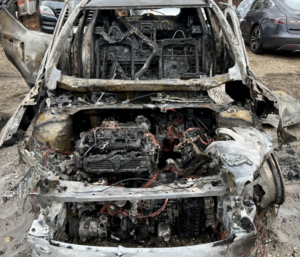
WAI Europe innovates EV charging cable with thermal cut-off, claims to reduce fire risk
By onCollision Repair | Repair Operations | Technology
A new product may serve as an idea to aid collision repair facilities in avoiding fire risks from thermal runaway when charging electric vehicles (EVs), especially if left unattended.
It’s always important to make sure your center has the proper electrical setup for EVs and that all employees — whether hands-on with EVs or not — are aware of hazards and safety guidelines at or near the vehicles.
Charging runs the risk of fire from the cord or plugs reaching high temperatures during prolonged use, which is when a charging cable with a built-in thermal cutoff switch might come in handy.
Richard Welland, president of WAI Europe, told The EV Report, “WAI cables will be the first in the market to have a thermal cut-off built in, ensuring that users can trust in the enhanced safety layer should high temperatures arise.”
Having thermal imaging cameras, four-gas meters, vehicle fire blankets, fire retardants, and overhead sprinkles on hand are among the ways shops can prepare themselves, according to a report from a working group of the Suppliers Partnership for the Environment (SP). The group includes OEMs such as General Motors, Honda Development and Manufacturing of America, Stellantis, and Toyota as well as other companies involved in the EV value chain.
If a thermal event occurs at a repair center, the runaway can be stopped by letting the battery burn itself out, spraying the battery with a hose, or placing it in a tub of water, according to the report.
As noted by I-CAR, the first step when handling EVs is to run a pre-repair scan of the vehicle where it sits, before moving it inside the facility. That’s because when an EV is in a collision, its high-voltage battery pack can be damaged by the impact, even if there’s no apparent physical damage. If internal damage has caused a voltage deviation across two or more cells, that creates resistance, and that resistance will create heat that can lead to a fire.
This is another reason, among a multitude of them, why OEM repair procedures should always be followed not only for safe and proper repairs but for the safety of technicians and all repair center employees, even the tow truck driver who drops EVs off for repairs. OEM Emergency Service Guides (ESG) are good documents to have on hand as well to follow in an emergency as thermal runaway handling can vary from vehicle to vehicle.
There’s also knowing how to handle safety systems and properly run diagnostics from low and high-voltage disconnects and pre- and post-scanning to battery cooling and enclosure testing; much of which was covered during a presentation at a Collision Industry Conference (CIC) meeting held earlier this year.
When an EV is first brought to a shop, thermal imaging tests should be conducted to check for leaking carbon monoxide, carbon dioxide, and hydrogen fluoride. Thermal imaging is more than what some collision repairers may be used to because more needs to be evaluated than just the temperature of the battery cells, according to Energy Security Agency Chief Operations Officer Dalan Zartman.
Scanning, he said, will show the temperatures of each of the hundreds of individual battery cells that make up the pack, flagging a potential problem.
When it comes to charging, WAI’s thermal cutoff switch activates when specific temperatures are reached, shutting off the charger to prevent electrical damage and fire, according to The EV Report. It then automatically restarts once cooled.
The cables work with multiple vehicle brands including Audi, BMW, Tesla, Jaguar, Kia, and Hyundai, and include type 2 female to type 2 male and type 2 female to UK and EU plugs.
Having a cable like WAI’s can also aid in mitigating liability from improper handling of customers’ vehicles.
“What we find statistically is small measures of intervention, following the manufacturer’s best practices negate the vast majority of the events that we see both in storage yards, in handling procedures, and in interaction procedures with these vehicles,” Zartman said. “Taking the time to apply the right steps at the right moments negates a huge quantity of the risk and liability and eventual hazards.”
The ESA’s 24/7 Guidance Center is also an option for help in filling the gap between best practices and standards in the entire custody chain of EVs and hybrid vehicles from first responders to towing and recovery, recyclers, salvage yards, and the collision repair industry. The center is staffed by first responders who collaborate with engineers and have access to OEM vehicle engineering diagrams to create their own proprietary data maps by make, model, and year.
With that information on hand, the center is able to provide real-time assistance to those who call in post-collision in addition to working with state and federal departments of transportation, the National Highway Traffic Safety Administration (NHTSA), and the National Transportation Safety Board (NTSB).
Images
Featured image: An electric vehicle (EV) is shown burnt after the fire it was involved in was extinguished. (Credit: CIC)
